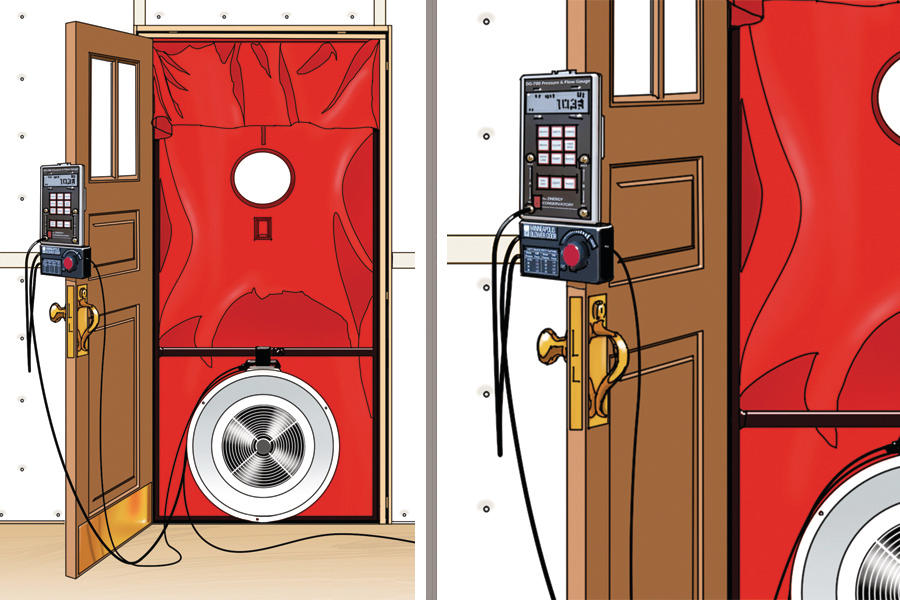
Pennsylvania Adopts 2018 IECC: How Residential Energy Code is Impacted
February 21, 2022The Pennsylvania (PA) Uniform Construction Code (UCC) Review and Advisory Council (RAC) has reviewed and adopted the 2018 International Energy Conservation Code (IECC). The 2018 IECC will take the place of the PA-amended version of the 2015 IECC. There is a six-month grace period during which projects in Pennsylvania can still comply with the PA-amended version of the 2015 IECC. The grace period applies to projects with design or construction contracts signed prior to February 14, 2022, and permits applied for by August 14, 2022. If your project is contracted after February 13, 2022, or permitted after August 14, 2022, the 2018 IECC will be required.
Envelope Leakage Test Limit Reduced from 5 ACH to 3 ACH
Although most of the changes to both commercial and residential sections are incremental, the residential section of the 2018 IECC includes one significant change from the PA-amended version of the 2015 IECC. Unlike during the last code cycle, when PA amended the 2015 IECC to allow five air changes per hour (ACH), PA adopted the 2018 IECC without any weakening amendments to the envelope leakage section. All buildings that meet the IECC definition of residential building are required to have an envelope leakage (blower door) test performed verifying no more than three ACH before the certificate of occupancy is issued. This 40% reduction in allowable air leakage is very impactful and requires planning.
An envelope leakage test measures how much air is escaping the building or dwelling unit, quantifying the airtightness. To perform the test, an energy professional such as a HERS Rater or Rating Field Inspector closes all windows and follows the ASTM testing standard outlined in the code to seal any applicable penetrations. The energy professional then sets up one or more calibrated fans using a metal frame and cloth shroud in an exterior door. The building or dwelling unit is then depressurized to an industry-standard pressure to measure the leakage.
Per Building Vs. Per Unit Testing
The IECC allows testing the building as a whole or each dwelling unit individually. For multifamily buildings, the type of envelope test can be a difficult choice. Per building tests are typically preferable for achieving low envelope leakage. However, the test can become expensive and impractical if the building envelope cannot be pressurized from a fan at one location. For example, an apartment building with a common entrance and hallway will be relatively easy to test as a building. Per building envelope testing might not be feasible if there is no common hallway and each apartment has an entrance directly to the exterior. Additionally, the construction schedule needs to allow all units to be completed simultaneously to test per building.
Historically, many Pennsylvania builders have preferred per unit envelope leakage testing under the PA-amended version of the 2015 IECC since it is more cost-effective and straightforward than per building testing. However, per unit testing poses challenges under the new 3 ACH threshold in the 2018 IECC. Achieving 3 ACH with per unit testing can be quite difficult in multifamily residential buildings. Leakage at the party wall is common and hard to control. Party walls are designed to prevent fire from spreading from one unit to another. Due to the fire code, insulation and air barrier options are limited for party walls, thus allowing for more air exchange. This results in higher air leakage, making achieving the 2018 IECC limit with per unit testing a significant challenge.
Pennsylvania builders are left to choose between feasibility and cost-effectiveness regarding the 3 ACH limit in the 2018 IECC. To increase your chances of achieving 3 ACH, see the list of tips below.
Tips for Passing the Envelope Leakage Test
- Have a trained energy professional such as a HERS Rater or Rating Field Inspector inspect air sealing details before installing drywall.
- Start early when you still have a margin for error. Utilize homes permitted under the PA-amended version of the 2015 IECC to understand what additional work will be required for achieving the 2018 IECC standards. Don’t wait until it counts to start your learning curve.
- The design team must consider the new testing requirements when specifying products. Designing more robust exterior air barriers will help your envelope leakage test results. Designing more robust exterior air barriers will help your envelope leakage test results.
- Ensure that your plans and contracts have notes for envelope leakage testing to ensure that the project team is aware of these requirements at the start of the project.
- For more complex buildings, an envelope plan review can be useful to address any potential leakage points and ensure that the plans reflect all details necessary to pass the envelope leakage test.
- Poorly sealed top plates can lead to air leakage. Ensure the top plate is sealed properly.
- To learn more, see our video about air sealing solutions. Although it mentions the 2015 IECC, the content applies to the 2018 IECC.